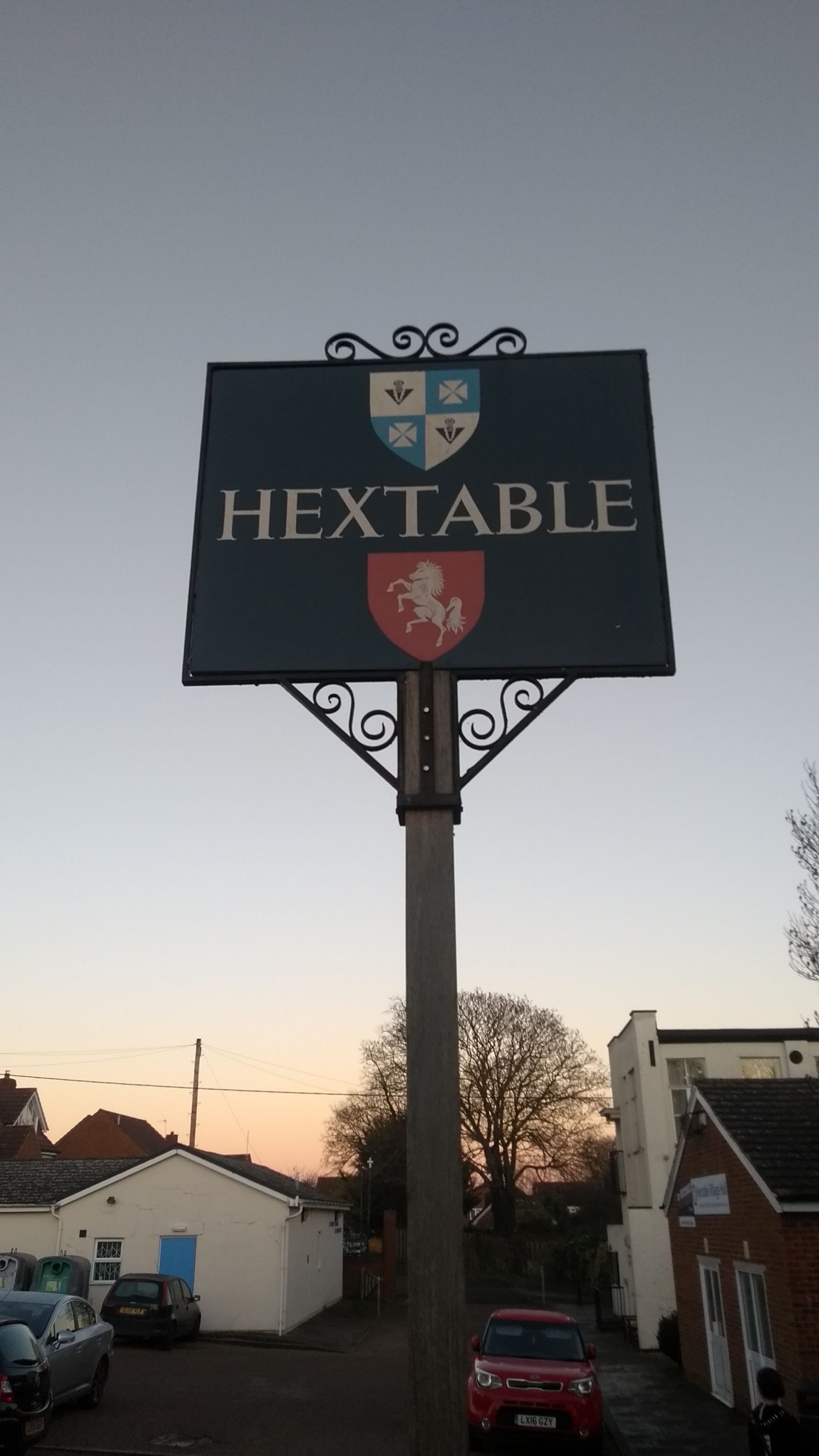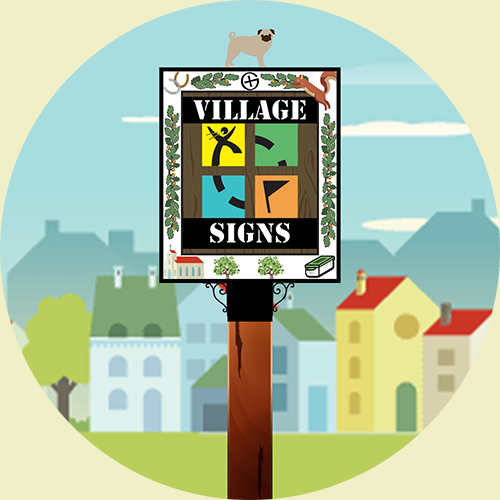Another in the Village signs series started by Smokeypugs.

Hextable is a village and civil parish in the Sevenoaks District of Kent. The origin of the village name goes back to Saxon times.
Its first documented appearance is in 1203 when the land is referred to as Hagestaple. Staple is from the Old English word "stapol," or boundary post. This makes perfect sense as the land was on the boundary of the Saxon settlements of Dartford, Bromley and Sutton at Hone. The word Hage is less clear. One theory is that it is descended from the Old English word for high: "Hey." But the land on the Birchwood side of Hextable, where the post would have been, is not high, at least compared with nearby Rowhill and Swanley Village, and it is hard to see how Hage would have derived from Hey. The Old English word "hage" meant a hedge, an enclosure or hawthorn, any of which could have been a means of uniquely delineating the boundary post in some way. The means by which Hagestaple became Hextable is in contrast well-documented:
13th century Hagestaple (1203 Roll of Rents)
14th century Hegestaple (1315 Bill of Sale of Highlands Manor of which Hegestaple was a part)
18th century Hackstaple (Various maps, including Hasted's History of Kent)
19th century Hackstable (1868 Ordnance Survey Map)
20th century Hextable (1895 OS map and many other documents).
The village grew up in late Victorian times with the selling off of Hextable Farm in 1870 (prior to this there were only three houses on the land that now comprises the village). It was originally set up as an area for the well-to-do to live in fine villas. Many of these villas are still standing, although two, Southbank and Newbank in College Road, were recently demolished to make way for flats and townhouses. The village's to-date most famous resident, Arthur Mee, known for the Children's Encyclopedia, lived in one such villa, St David's. His most famous utterance on his home village was the withering, although a little inaccurate, statement "Hextable has no history!"
The village quickly grew beyond being just a retreat for the upper middle class with the coming of the railway at nearby Swanley Junction coupled with the fertility of the land and the mild climate. Nurseries were established in the area with their produce being quickly sent to London via rail. Many of the names of these now long-gone nurseries still persist in road names such as Emerson and Panters. Emersons Avenue was built upon "The Rec", an old recreation ground left by a resident in Victorian times "for the use of the children of the village in perpetuity". It is consistent with the fast-changing nature of Hextable that perpetuity only lasted 100 years. The railway drove the expansion of the village in the 20th century as a convenient dormitory village for north-west Kent and London, and this is its main purpose today.
Much of the initial development of the village in the early 20th century was memorialised in a collection of photographs from a village resident, Christopher Casstine. He was an orphan brought up in the Homes For Little Boys (opened in Hextable by the Prince of Wales, the future Edward VII, in 1883 and still standing as Furness School) who stayed on in the village opening up a photography studio on the main road to Swanley. His photographs were used for many of the local postcards as well as for Mee's Children's Encyclopedia. His name lives on in the road Casstine Close.
The disorderly growth of the village explains the rather jumbled architecture that dominates the village. Hextable House, which was the only house in the village for much of its life, was bombed in the Second World War and wantonly torn down.
The Avenue of Limes which was planted in Elizabethan times as a magnificent entranceway to the House still remains linking New Barn Road and College Road. There has been some replanting of the trees in recent years, and its full beauty can now be appreciated for half of its length, although the remaining half should be visible in the near future. The gardens of the old House, as would have been seen in its final role as an agricultural college, are kept up with the aid of Lottery money at the Hextable Heritage Centre. The outskirts of Hextable largely comprise farmland, stables and small woodland areas.
Notably, there are no pubs within the village, due to restrictions placed by former landowners in the late 19th century, although there are pubs to be found on its woodland outskirts.
According to the census in 2001, Hextable has one of the highest percentage number of households with two or more cars in the country.
This a multi that hopefully takes you on a nice walk to the cache.
You should be standing at the village sign. Unfortunately, since I first initially came here, one side of the sign seems to have disappeared.
On the brick pillar is a white sign with 7 words (A to G) and a picture (H) on it. Use the number of letters in each word to work out the co-ords of the cache
N51 24. D+G E-H A-F
E0 10. A-E C-D B*G
You are looking for a small screw topped container.
About Village Sign Caches
|
 ⠀ ⠀ |
This cache belongs to the Village Sign Series, a series of caches based on ornate signs that depict the heritage, history and culture of the villages that put them up (generally on the village green!).
The signs can be made of different materials from fibreglass to wood, from forged steel to stone. They can depict anything from local industry to historical events. The tradition probably started in Norfolk or Suffolk and has now spread across most of the country so we thought we would base a series on them!
|
More information, bookmarks and statistics can be found at the Village Signs Website
If anybody would like to expand the Village Sign Series, please do.
I would ask that you request a number for your cache first at www.villagesignseries.co.uk
so we can keep track of the Village Sign numbers and names to avoid duplication.